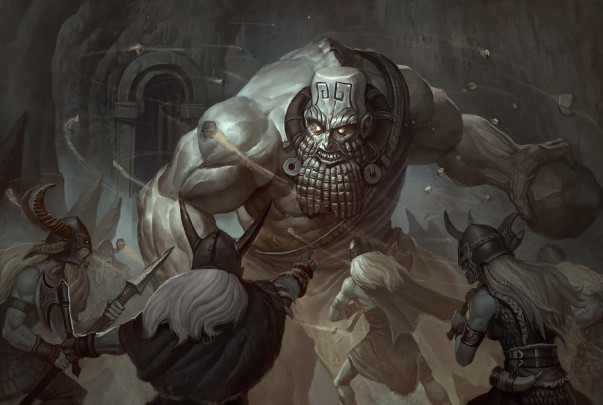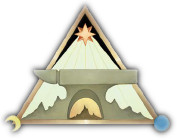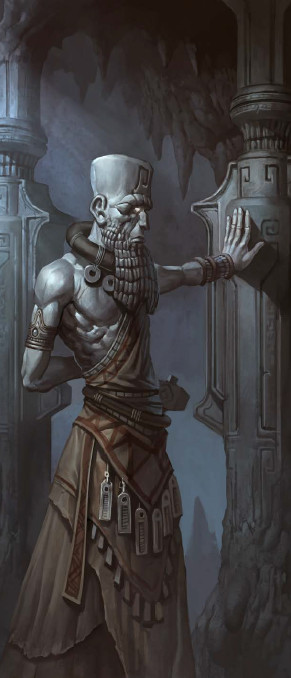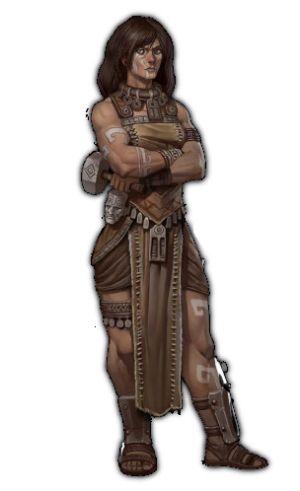Minderhal

- The god Minderhal (MIN-der-hawl) is a stone giant deity of law and crafting, but his worship gained popularity with other humanoid races when the Runelords ruled western Avistan. Mortals prayed to Minderhal for advice on matters of architecture, justice, law, metalwork, and stonework. With the collapse of the Thassilonian empire, however, Minderhal’s religion fell out of favor, and now his following is almost exclusively limited to a few tribes of evil stone giants, who revere him for his mighty strength, skilled hands, and unyielding upholding of ancient traditions. As more and more stone giants have turned away from revering deities in favor of ancestor worship, Minderhal has grown increasingly angry about the decline of his influence, and he now broods over ways to regain the power and influence he once held.
Introduction

Stone giants have an ancient culture, and according to their lore, all other giants were created from their kind. Long ago, they worshiped Minderhal, Fandarra (Pathfinder Campaign Setting: Inner Sea Gods 188), and Erastil (whom they call Estig the Hunter and depict as a fur-clad stone giant), along with spirits of the earth and their ancestors. Today, most stone giants prefer to pay homage to these spirits rather than the gods. Still, although Minderhal’s influence has been on the wane for centuries, many evil stone giants—especially evil stone giant elders—embrace his teachings, following his guidance on how to build weapons, carve stone, maintain their homes, and tan furs. Minderhal represents the power of traditions to reinforce a culture’s accomplishments and behavior. As the mass abandonment of his worship has shown, however, he also serves as an example of how such a rigid focus on rituals can cause a culture to stagnate.
Also known as the Lord of Giants, the Maker, or (more formally) He Who Makes and Unmakes, Minderhal treasures his worshipers as if he had crafted them out of raw stone with his own hands. He is filled with contempt toward those who have turned their backs on him, like a master sculptor condemning a journeyman who dared strike out on her own without his explicit blessing. Communications with his faithful are slow and ponderous; each word is assigned great weight and laden with context about the past and the future.
He Who Makes and Unmakes is paternalistic and domineering. He teaches that his way is the only right way, that resisting change is better than accommodating it, and that it is natural for the strong to dominate or destroy the weak. Minderhal encouraged his worshipers to accept the yoke of their evil Thassilonian masters in exchange for political clout and magical might; the physical power of the mighty giants (and their god-granted talents for working stone) earned the admiration of many members of the smaller races, spreading Minderhal’s faith to new audiences. However, many stone giants resented the willingness of the Maker and his followers to sacrifice them to gain the rewards offered by the human conquerors. Stone giants have long memories, longer lives, and a detailed oral history, and now Minderhal is paying the price for decisions he made thousands of years ago. Although young stone giants are taught the history and religion of their kind, in many tribes these lessons speak of Minderhal with scorn. He’s given faint praise for his might and skill, but is otherwise condemned. Among tribes of evil stone giants, he is still the primary deity, but he faces challenges from Urazra, a younger, more aggressive evil giant deity (see the sidebar on page 72).

Minderhal instructs his followers with well-worn adages, wise parables, and poignant philosophical questions that can be answered only after long introspection. Faith, history, knowledge, and works of skilled craftsmanship are respected. Superiors and existing practices should not be challenged; if there is a conf lict, it is better to exile yourself with dignity than to shame yourself and your tribe by violating a taboo or disputing a tradition.
Minderhal’s stone giant worshipers prefer to portray him as a bearded, strong, and wise elder giant, carving his image in soft stone to capture his strength and the nuances of his power. At the height of his popularity, he was depicted either as a powerful crafter and builder or as a raging, rocky colossus. Evil tribes tend to show him with narrowed eyes, clenched hands, and a frowning mouth, representing his scrutiny, swift discipline, and admonishments.
Minderhal can fight with his huge, stony fists, but prefers to use his magical crafting hammer, Weight of Tradition, which he can throw and retrieve like a returning weapon. The deity shows he is pleased by stone chips that show his face or holy symbol appearing when stones are struck, heavy burdens becoming light, and the sound of clean water bubbling over rocks. When he is angered, the ground collapses into pits, arches settle and release dust, and skin momentarily cracks like parched earth in a desert. Minderhal is lawful evil, and his portfolio is creation, giants, justice, and strength. His weapon is the warhammer.
His holy symbol is an anvil on a cave f loor in front of a triangular background with a moon, a planet, and a star, respectively, at the corners. His domains are Artifice, Earth, Evil, Law, and Strength. Most of his worshipers are stone giants, but some Kellid tribes in the northernmost reaches of the Realm of the Mammoth Lords favor him for his might. His priests are primarily clerics, with a few inquisitors who slay heretics before they can turn tribes away from the worship of Minderhal. Aside from the aforementioned human tribes, Minderhal’s faith is mostly confined to stone giants dwelling in mountainous regions, especially ranges in western Avistan such as the Iron Peaks, Kodar Mountains, and Mindspin Mountains.
The god keeps his divine realm of Stonepeak—a chain of unbelievably tall mountains threaded through with cave lairs—just outside the edge of the first layer of Hell, within sight of the smoky volcanoes of Avernus. Hills ring this realm, above which the air becomes too thin to breathe on foot. Unwanted visitors are stunned by earthquakes and pelted with boulders thrown by the god’s petitioners. The mountain itself is a paradise for crafters; there the souls of stone giant elders produce gems, weapons, and other treasures, always using traditional methods under the stern eye of the god himself.
A typical worshiper of Minderhal is an evil stone giant, Taiga giant, or Kellid human following generations of tradition in his or her tribe. Most focus on one aspect of the god’s portfolio and become a champion of that area, such as by becoming a master artisan, an enforcer of traditions, or a warrior. They reject new ways of thinking and acting, stubbornly clinging to the ideas that kept previous generations alive and strong.
Worship services combine deep-voiced songs, notes on a lithophone made out of stalactites or crystals, and pebbles shaken within a hollow stone (such as a geode). Those sounds are punctuated by supplicants throwing crafted offerings into a bottomless pit or crushing them under a boulder. The Maker’s church has a very strong tradition of marriage, and most tribes are led by a married couple. Deformed, sickly, or weak infants are left on a mountaintop to die, and choosing to raise one instead of disposing of it in this matter is considered an admission of weakness.
TEMPLES AND SHRINES
Minderhal’s faithful prefer to augment natural stone structures rather than build completely new ones, but with giant strength, the difference between building and merely augmenting is blurred when compared to human construction. For an aboveground site, priests might relocate a dozen menhirs to form a triangular pattern, or stack human-sized boulders to form a ring or wall. Underground, they reinforce and expand entrances to natural caverns of great beauty, carve stalactites and crystals into resonating musical instruments, and build hundreds of alcoves to hold the vurras (see page 74) of past members of the tribe.
Shrines to Minderhal usually consist of a large isolated piece of stone that already looks like a giant head, which the giants shape to more closely resemble the god or a notable hero. Rather than placing secret compartments within these shrines, worshipers hide things under them in tile-lined spaces that can be accessed only by using great strength to lift or tilt the heavy stone.
Minderhal’s Anvil is the god’s most famous temple. It was originally built of gleaming marble and housed a massive forge-altar. Its remaining walls, which overlook the shore of the Storval Deep in the Iron Peaks, still attract a few stone giant pilgrims each year. Stories claim that an enormous crypt under the Anvil holds the remains of important stone giant elders, but the entrance stones are too heavy for human-sized creatures to move, and the giants who visit the place give its buried crypts a wide berth. Within the catacombs themselves, numerous horrors of eons past lurk behind basalt pillars and in massive sarcophagi, including giant mummies and the dreaded horrors known as inverted giants. (For more information on inverted giants, see page 60 of Pathfinder Campaign Setting: Lost Kingdoms.)
In ancient days, Minderhal’s warrior-priests owned hundreds of mammoths trained in mounted combat. Although the use of war mammoths has faded among many tribes, it is common for temples to capture and train at least a few mammoths for this purpose. These animals are always treated with reverence.
A PRIEST’S ROLE

A priest of He Who Makes and Unmakes is expected to maintain the tribe’s traditions, interrogate those who violate cultural taboos, and escort exiles to the edge of the tribe’s territory to make sure the offenders leave. If a tribe keeps slaves, its members are expected to educate these slaves in “proper” religion and stamp out any superstitions or worship that goes against what Minderhal teaches. It is traditional for priests to create a certain number of high-quality tools or weapons for the tribe each year, replacing them if they are damaged. A priest is often an advisor to a tribal leader, and it’s common for senior priests to take on a leadership role within the tribe. Minderhal’s clerics are usually trained in Climb, Craft (stonemasonry), Handle Animal, Knowledge (engineering), and Knowledge (history).
Giant priests have little interaction with those outside the tribe. They do not even attempt to evangelize to other giants, as the priests believe these “degenerate” races irrevocably turned their backs on Minderhal long generations ago, and must submit themselves of their own volition to be brought back into the fold. Human priests are more outgoing and persistent about their faith, and often brag to strangers that their god gives them physical might and the will to resist corrupting inf luences. It is common for priests to paint gray streaks on their faces with a paste made from powdered stone. Stone giants use a subtly different shade of gray than their natural skin color so as to not contrast too much and interfere with their ability to blend in with the surrounding stone.
HOLIDAYS
Though worship of Minderhal has waned over the years, those who still follow his teachings celebrate the following holidays.
Day of Making and Unmaking: On the spring equinox, stone giants who revere Minderhal use the day to bring the community together with an eye toward creation and purging their community of undesirable elements. To honor the god’s Maker aspect, worshipers craft hammers and tools during this holiday; some of the most treasured tools a stone giant possesses were likely created on this day. Sometimes the community instead comes together to build a structure for shared use or work on the creation of a new shrine or altar. To honor Minderhal’s Unmaker aspect, his followers treat this holiday as a somber time when members of the community are judged by how closely they follow their ancestors’ traditions. Those found unworthy are tested by various means; if they fail, they face exile.
Day of Stone Justice: Each year on the winter solstice, members of a stone giant clan can bring their disputes in front of the elders to petition for justice. The most respected elders hear arguments from each party and dispense judgments on the matter.
RELATIONS WITH OTHER RELIGIONS
Minderhal is ancient but has little inf luence outside of the giant tribes. He knows he cannot throw his weight around with respect to most other deities. His policy is avoidance rather than confrontation, as he feels it diminishes him to engage with the gods of lesser races, even though those gods may be of equal or greater power. He likewise avoids the gods of the other giant races except when they make war on his people. He is respectful toward Asmodeus, however, for his domain borders Hell and he is wary of the Prince of Darkness’s greater experience and power. For the sake of tradition, he welcomes the ancestor and stone spirits who visit his realm, but he can’t help but be secretly jealous of them because so many tribes of giants have completely abandoned his faith in favor of spirit worship The Maker is on coolly cordial terms with Fandarra, much like former spouses or relatives who disagree on matters but are polite to each other for the sake of their descendants. The two have not openly argued since the time of the Runelords, and mortal giants often make offerings to both of them with polytheistic prayers.
Parts of Minderhal’s holy text even refer amiably to Fandarra, and include prayers to both deities.
Despite the deities’ differences in alignment, Minderhal is friendly toward Estig (Erastil). For his part, Estig treats Minderhal like his family’s black sheep—one who is tolerated at times but is ultimately an embarrassment. Even though the threads of tradition and hunting are the only things that tie the two deities together, Estig doesn’t shirk his duties as the hunter god of his stone giant worshipers. This arrangement sometimes creates schisms between Erastil’s faithful.
Urazra is Minderhal’s admitted enemy, but Minderhal is unsure whether he can defeat the warrior deity in a direct confrontation. Instead, he repeats his adages about how traditions and crafting have allowed the giants to survive for thousands of years, and warns his people that reckless aggression against smaller folk is only a short-term strategy that cannot sustain itself.
NEW SPELL
Clerics of Minderhal can prepare repel metal or stone as an 8th-level spell, spike growth as a 3rd-level spell, and stone tell as a 6th-level spell. His priests are fond of the returning weaponUC spell and have access to the following spell as a 4th-level cleric spell. ===GRAVEL VORTEX===
School conjuration (creation) [earth]; Level druid 4, sorcerer/ wizard 4
Casting Time 1 standard action
Components V, S, M (handful of pebbles)
Range long (400 ft. + 40 ft./level)
Area cylinder (20-ft. radius, 40 ft. high)
Duration 1 round/level (D)
Saving Throw none; Spell Resistance yes
You create a hail of tiny pieces of rock and dust that batter and scrape against all things in the area, dealing 5d6 points of bludgeoning damage. This damage is dealt only once, on the round the spell is cast. For the remaining duration of the spell, fne dust rains down in the area. Creatures other than stone giants inside this area take a –4 penalty on Perception skill checks, and the entire area is treated as diffcult terrain. At the end of the spell’s duration, the gravel and dust disappear, leaving no trace of their presence.
PLANAR ALLIES
Most divine servants of Minderhal are either ascended stone giants or such giants’ spirits bound to living stone colossi.
Elder Krengath: This elegant female stone giant has skin resembling black marble. A tribal elder and an accomplished priestess in life, she takes a conservative tack with any mortal who wishes to bargain for her services. She appreciates offerings of hand-carved stones bearing the holy text of Minderhal.
Vostalar: This unusually sturdy stone giant elder has glowing runes on his chest and shoulders. Stubborn and intractable, he is unpopular among mortal worshipers, but when convinced that a cause is worthy of his time, his hammer is deadly and he is resistant to most magic that would kill a lesser giant outright.
HOLY TEXT
Minderhal’s faith is described and explained in a series of engraved polished rocks called One Hundred Sacred Stones. Traditionally, each chapter is written on its own stone, which must be of a certain size, shape, and color that suits the message of that particular chapter. Some chapters require that their stones be found underground, others must be found in water, and still others are worthy only after they have been burned in a bonfire for a week. The verses are also preserved in a song, just in case a tribe is forced to leave its sacred stones behind
APHORISMS
Minderhal’s worshipers are cantankerous and territorial, unwilling to let outsiders encroach on their land, and their sayings ref lect this nature.
Carry the Second Stone: It is customary to drive away an invader with a near-miss from a thrown boulder. The second boulder strikes to kill rather than warn, and sayings referencing this second stone are common among Minderhal’s faith. This saying means a giant should always be ready to protect home and tribe, and have the strength to do so. A weak giant would pick up the second stone only if needed; a strong giant always carries it.
The Stone Will Teach You: A wise crafter realizes that different materials are best suited for specific tasks. Using the wrong tool or material will break it or create a flawed item. Just as artists say carving a horse out of rock is just cutting away the parts that don’t look like a horse, Minderhal teaches that some stones are meant to be carved into knives, some are best carved into hammers, and some are suited only for throwing. It’s better to discard a thing than to try and change it into something it wasn’t meant to be. It is this philosophy that makes Minderhal’s followers leave weak infants to die of exposure, and exile troublemakers and heretics rather than forcing them to comply.
OBEDIENCE
The following information describes the ritual a worshiper of Minderhal must perform to take full advantage of the Deific Obedience feat found in Pathfinder Campaign Setting: Inner Sea Gods, as well as the boons for the evangelist, exalted, and sentinel prestige classes.
Obedience: Spend an hour working a piece of stone into a tool, a vurra, a weapon, or a stone that is destined to be engraved as part of Minderhal’s holy text using only your hands or a tool that uses only your own strength and skill (rather than something that requires another person such as a long saw or a machine such as a mill). Recite relevant passages from One Hundred Sacred Stones while you craft this object. Gain a +1 profane bonus on Strength checks and on attack rolls with thrown weapons.
EVANGELIST BOONS
1: Master of Earth (Sp) expeditious excavationAPG 3/day, instrument of agonyUC 2/day, or burrowUM 1/day
2: Hands of Justice (Su) For a number of rounds per day equal to your Hit Dice, you can infuse your slams or a melee weapon you wield with the power of pure law. Your attacks with these weapons gain the axiomatic weapon special ability. Any attacks that would damage these weapons frst have their damage reduced by 5 before you apply DR, hardness, or any resistances. Activating or dismissing this ability is a free action, and the rounds need not be consecutive. Any weapon affected by this ability returns to normal 1 round after it leaves your hands.
3: Maker’s Gift (Su) Once per day as a full-round action, you can grant Minderhal’s gift of power to a willing humanoid creature by touching it. The target gains a +2 profane bonus to Strength or a +4 profane bonus on Craft checks relating to stone. A creature can have no more than one Maker’s gift from an evangelist at a time. As long as the gift persists, you can speak telepathically with the target across any distance (but this does not grant it the ability to reply). The Maker’s gift is removed by dispel evil or dispel law. You can remove the gift as a free action, dealing 1d4 points of Wisdom damage to the target as a result. The target cannot attempt a saving throw against this effect.
EXALTED BOONS
1: Will of the Unmaker (Sp) enlarge person 3/day, weapon of aweAPG 2/day, marionette possessionUM 1/day
2: Hands of Justice (Su) For a number of rounds per day equal to your Hit Dice, you can infuse your slams or a melee weapon you wield with the power of pure law. Your attacks with these weapons gain the axiomatic weapon special ability. Any attacks that would damage these weapons frst have their damage reduced by 5 before you apply DR, hardness, or any resistances. Activating or dismissing this ability is a free action, and the rounds need not be consecutive. Any weapon affected by this ability returns to normal 1 round after it leaves your hands.
3: Rocky Flesh (Sp) You gain a profane bonus equal to your Charisma modifer on your Fortitude saving throws and to your natural armor bonus.
SENTINEL BOONS===
1: Paragon of Greatness (Sp) compel hostilityUC 3/day, bull’s strength 2/day, haste 1/day
2: Rewarding Smash (Su) Whenever you confrm a critical hit with a melee attack, you heal a number of hit points equal to your Hit Dice or the target’s Hit Dice, whichever is less.
3: Avalanche of Might (Su) As a swift action, you can increase your physical might. You gain a +1 profane bonus on melee attack rolls, melee weapon damage rolls, Strength checks, and Strength-based skill checks, as well as DR 1/— until the end of your next turn. You can use this ability a number of rounds per day equal to your Hit Dice; these rounds need not be consecutive. If you use this ability on consecutive rounds, the duration resets; the bonuses from consecutive uses stack.
Urazra and the Bear CUlt
The cult of Urazra (oo-RAZ-rah) is only a few hundred years old, but has grown quickly in popularity among more brutal stone giants. This godling, also known as the Breaker of Bones, promises his followers great strength, fortitude, and immunity to pain in exchange for acts of savagery and sacrifices of flesh. The cult is contentious, even among evil stone giants. Many elder stone giants oppose the cult, claiming it plays to the worst, most bestial aspects of giant nature and rejects both wisdom and civilization. Charismatic preachers of Urazra claim that will and strength are more important than faith, history, knowledge, or craftsmanship. The bear cultists are largely young giants, eager to raid, rend, and torture rather than herd and craft. Many of his worshipers are barbarians and choose the bear as their totem animal. Urazra is chaotic evil, and his portfolio is battle, brutality, and strength. His weapon is a spiked gauntlet, and his domains are Animal, Chaos, Evil, Strength, and War.
VUrra
A vurra is a carving of a giant’s head made at about one-third actual size. It usually portrays a god but can instead depict a hero, historical figure, or loved one. Stone giants use them as focus items for religious rituals or, for non-godly representations, as remembrances or inspiration in their daily lives. Many are crafted with magic to protect a buried corpse, speak warnings to intruders, or watch over a family.